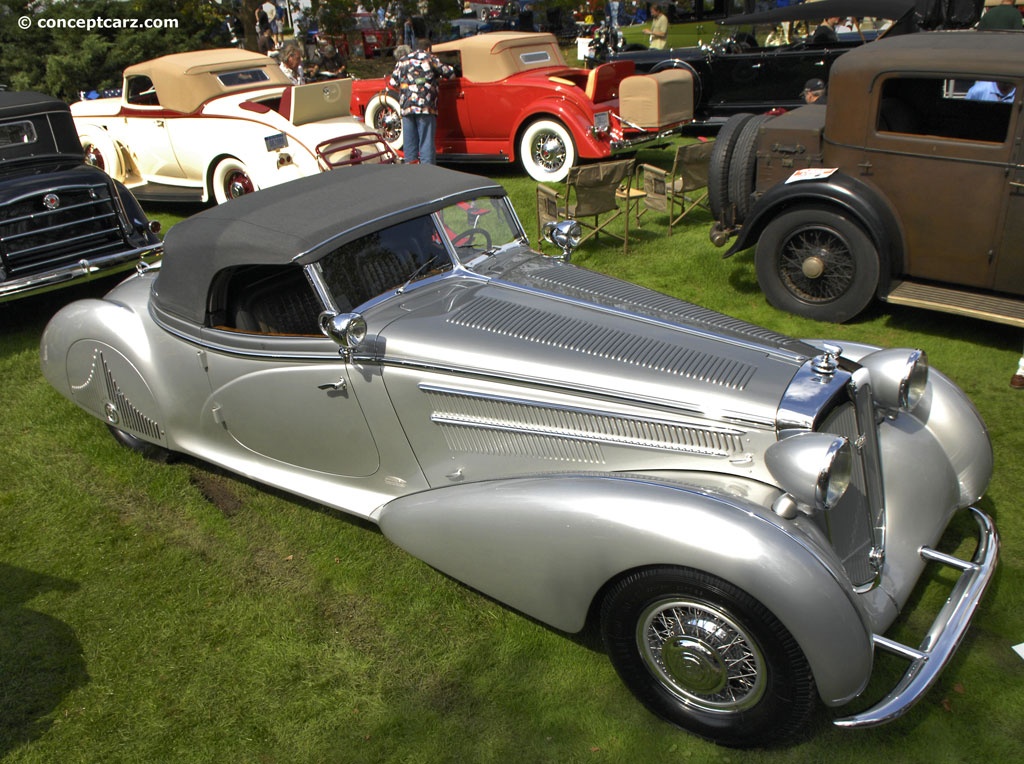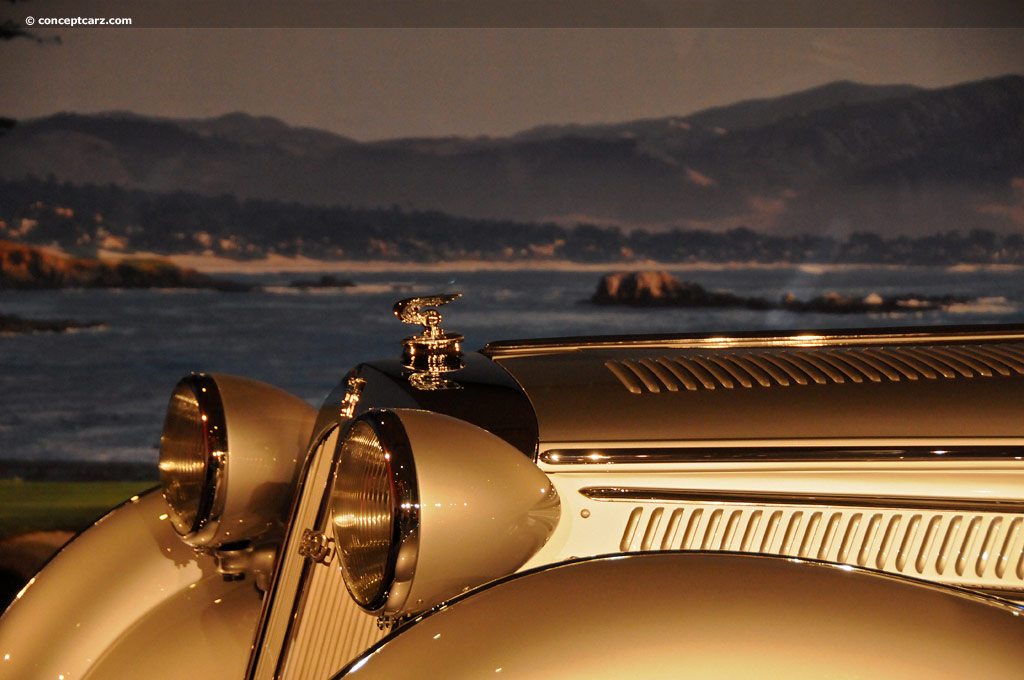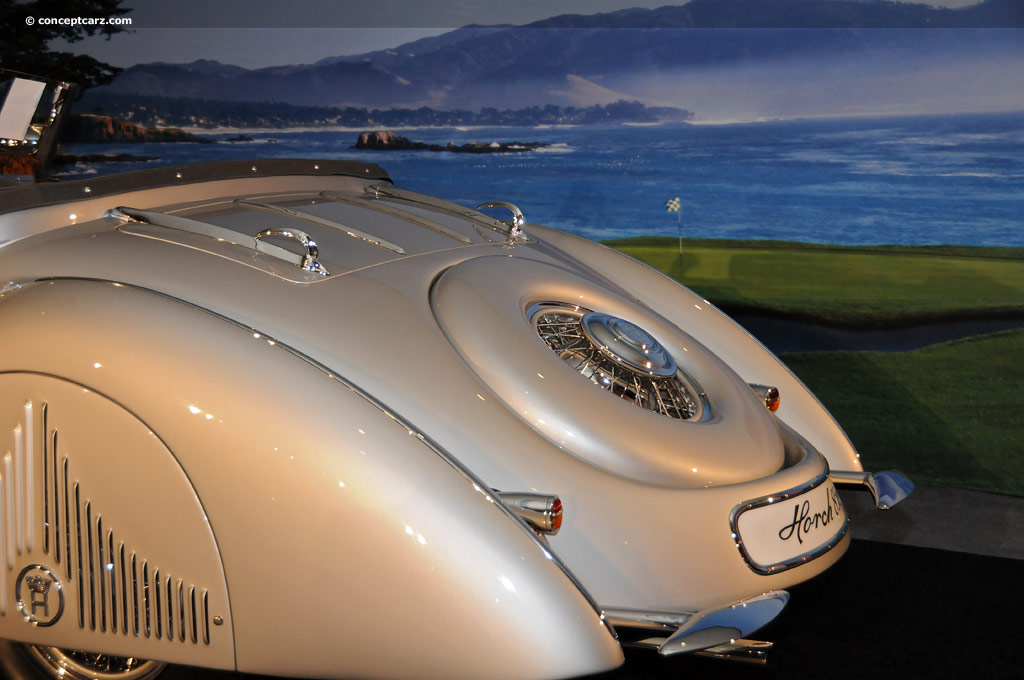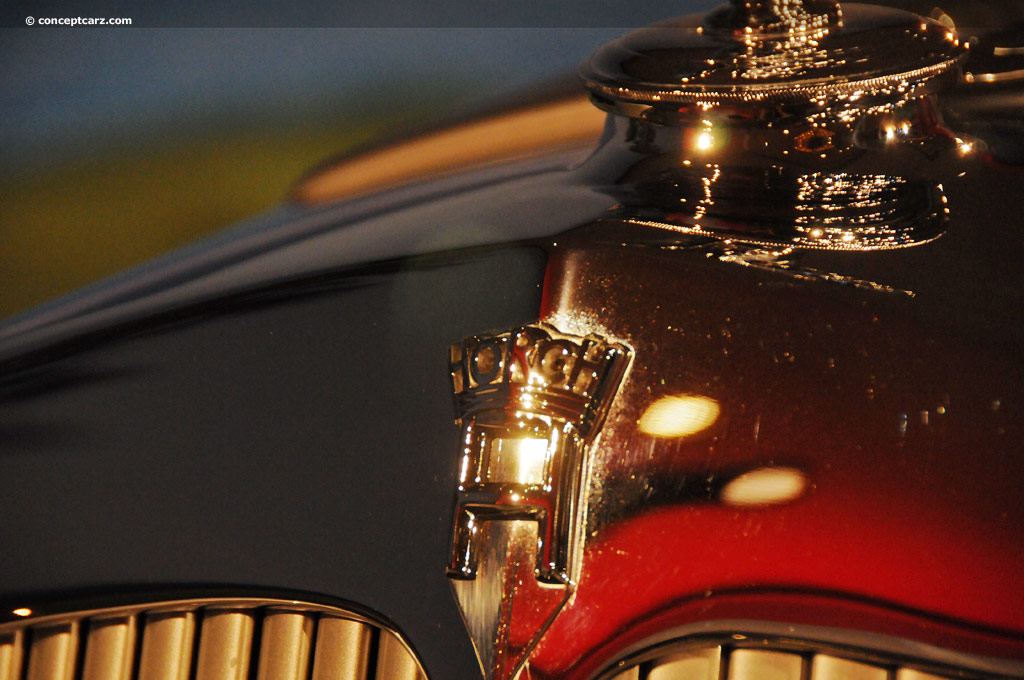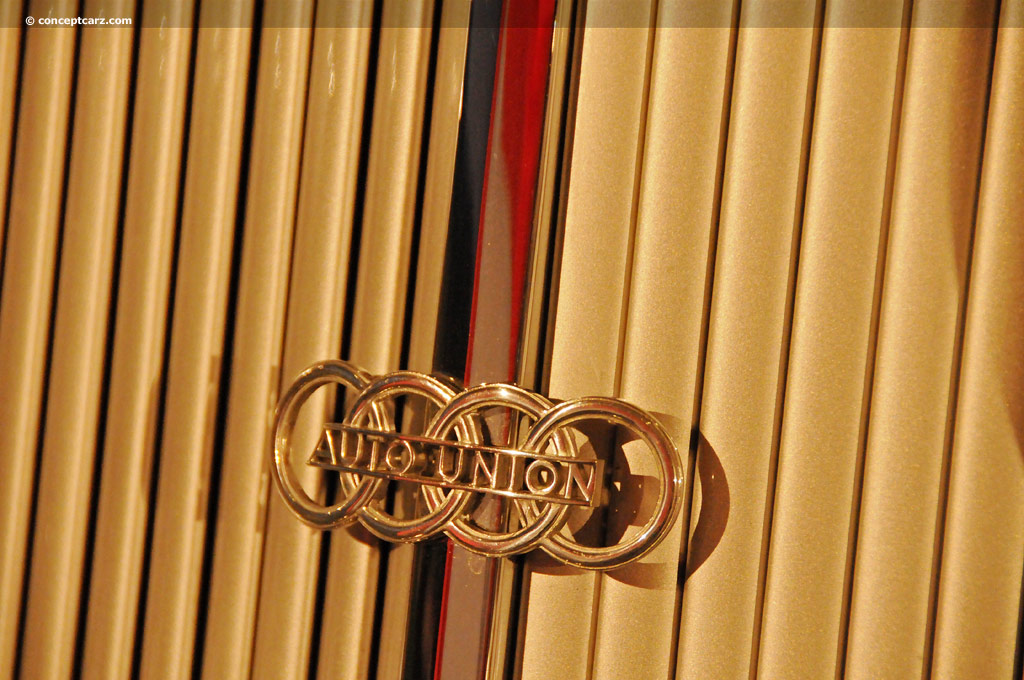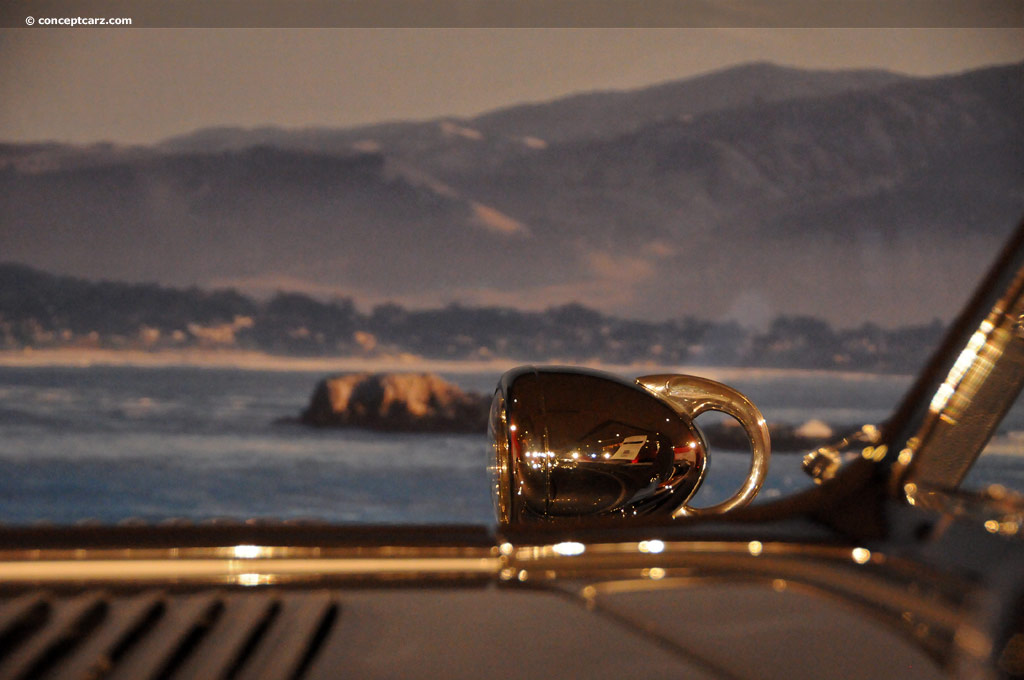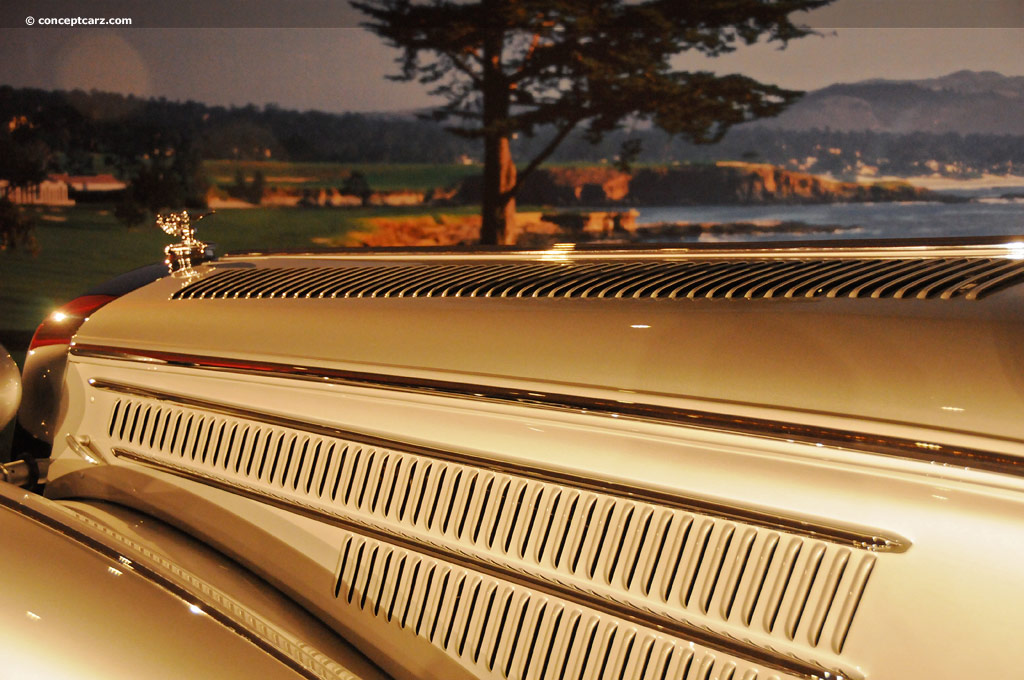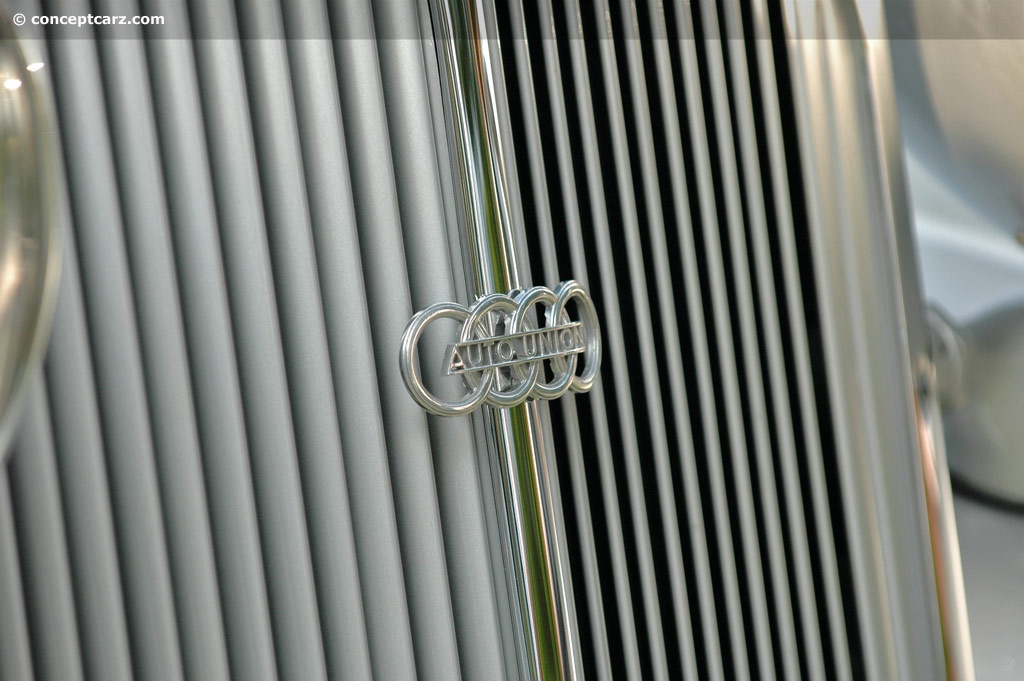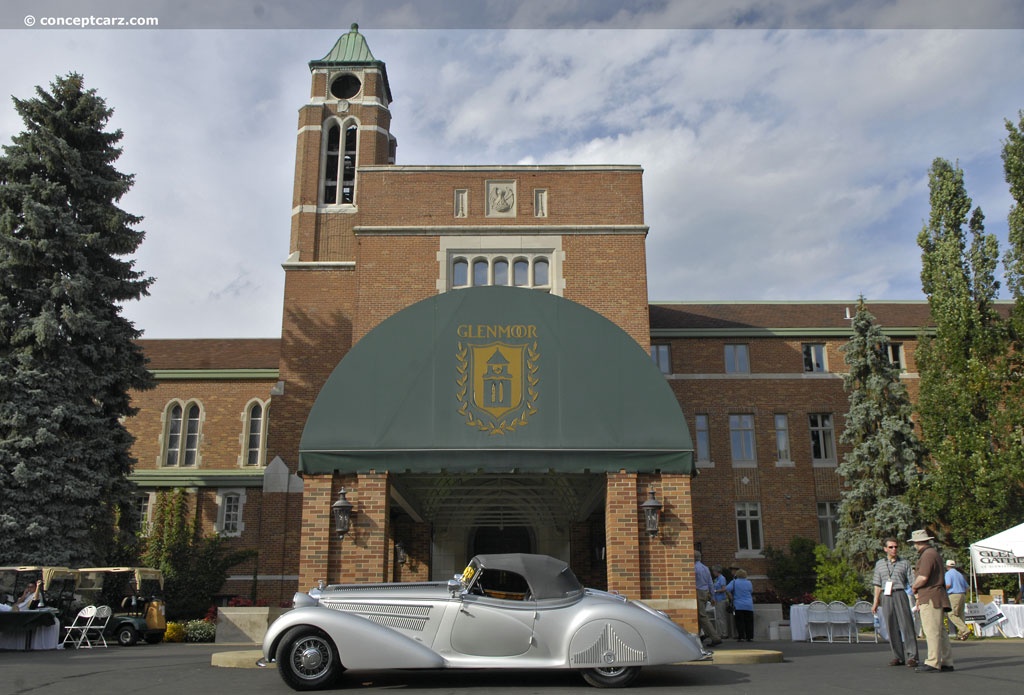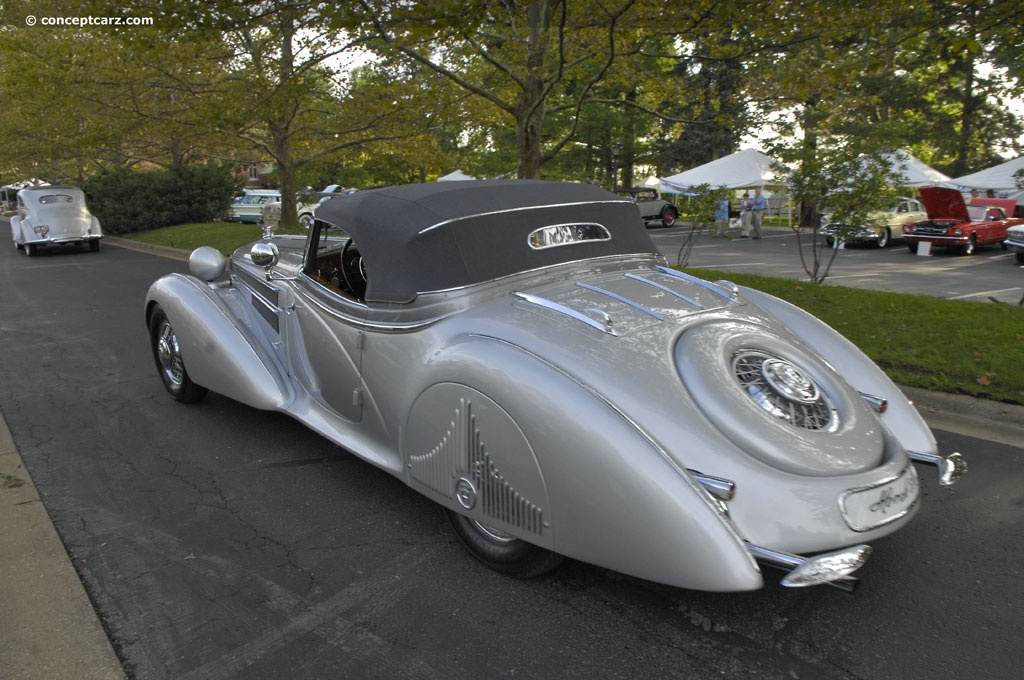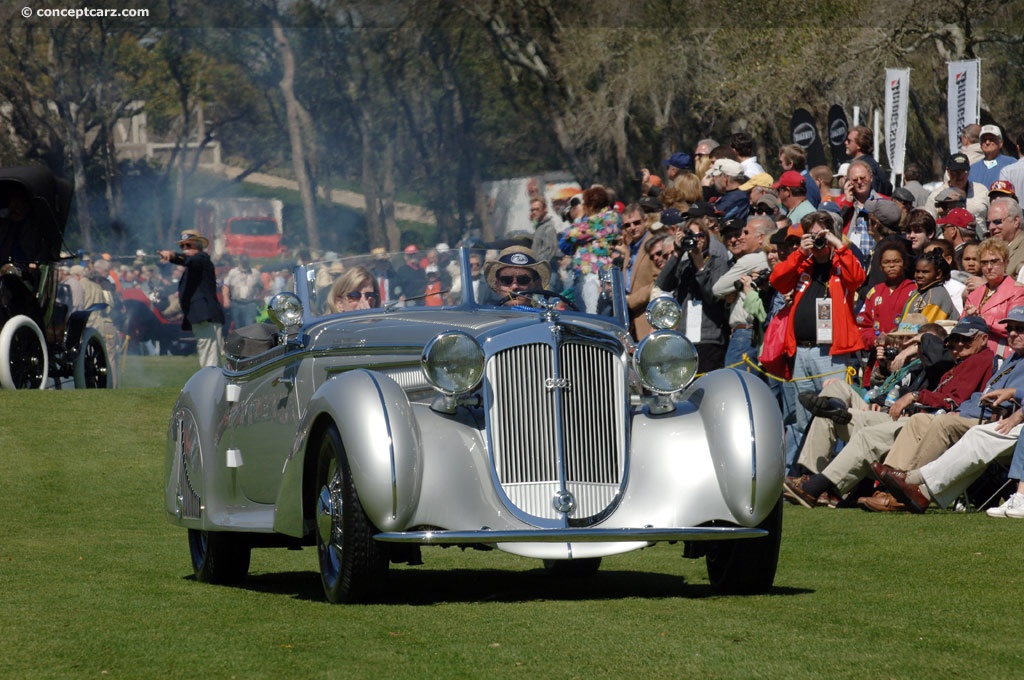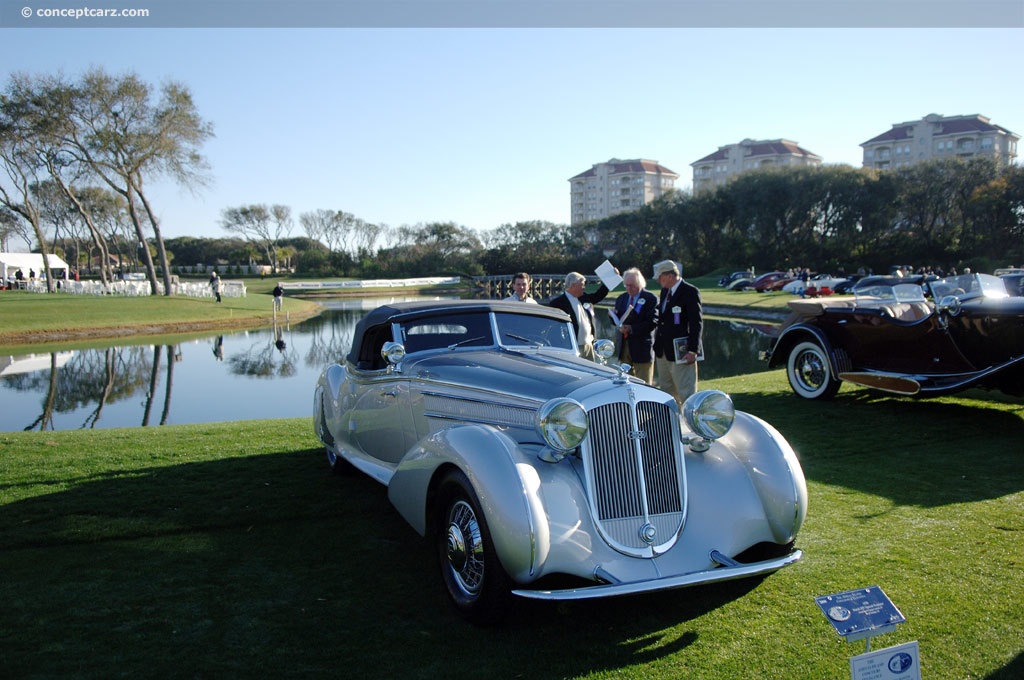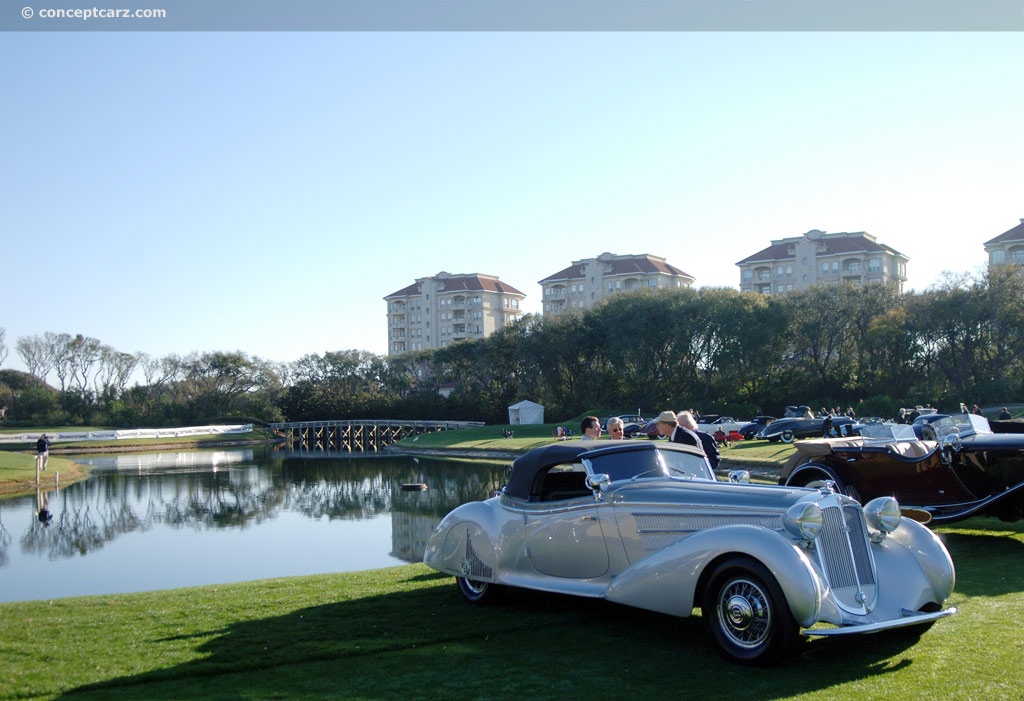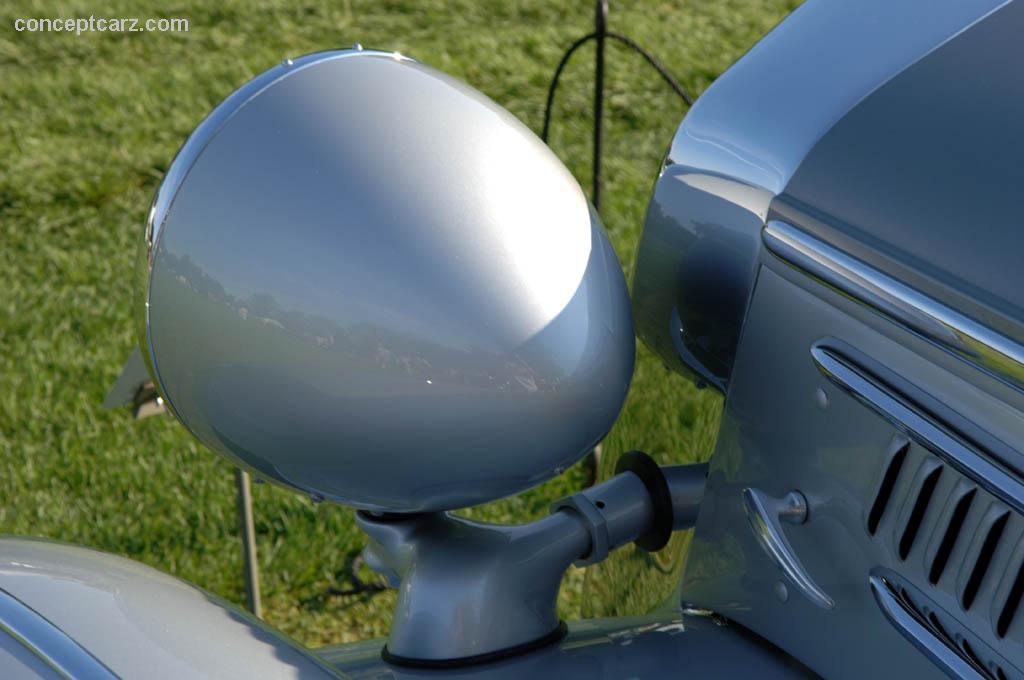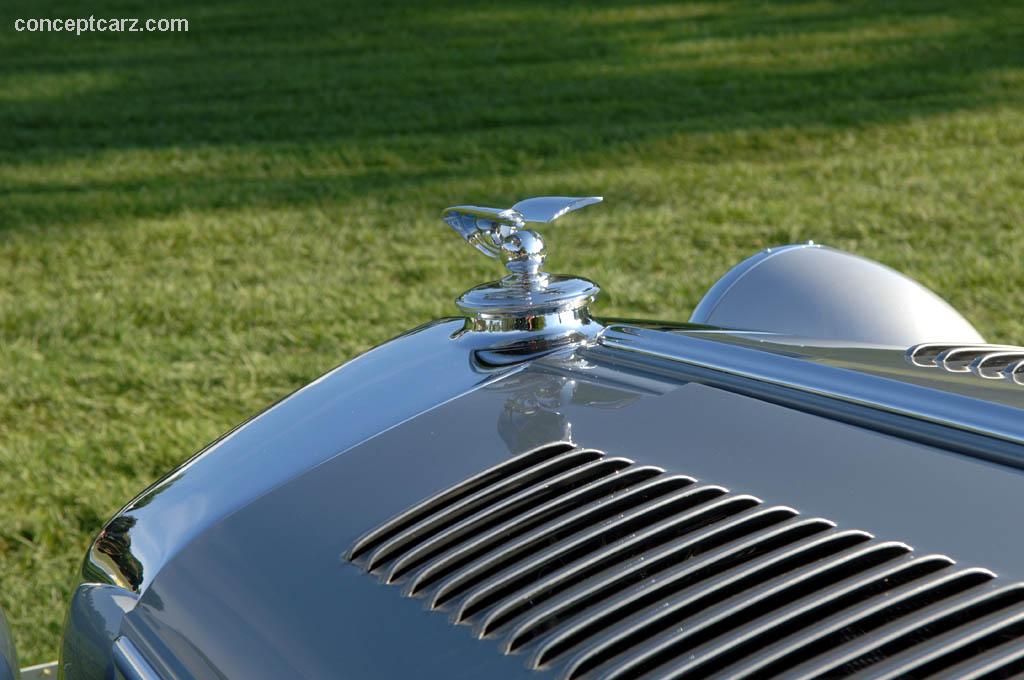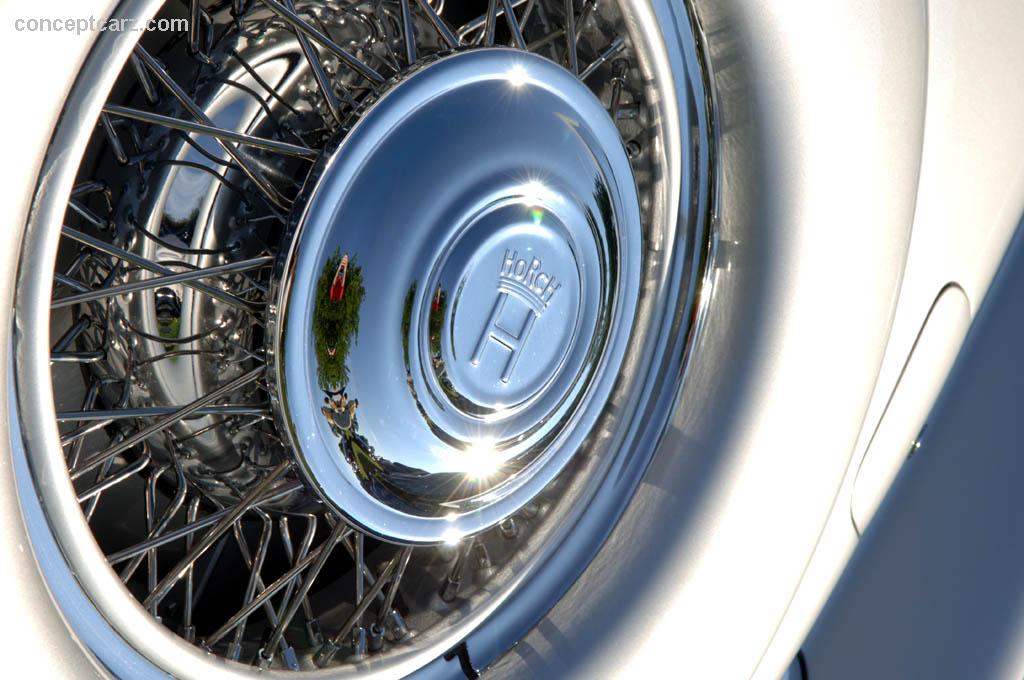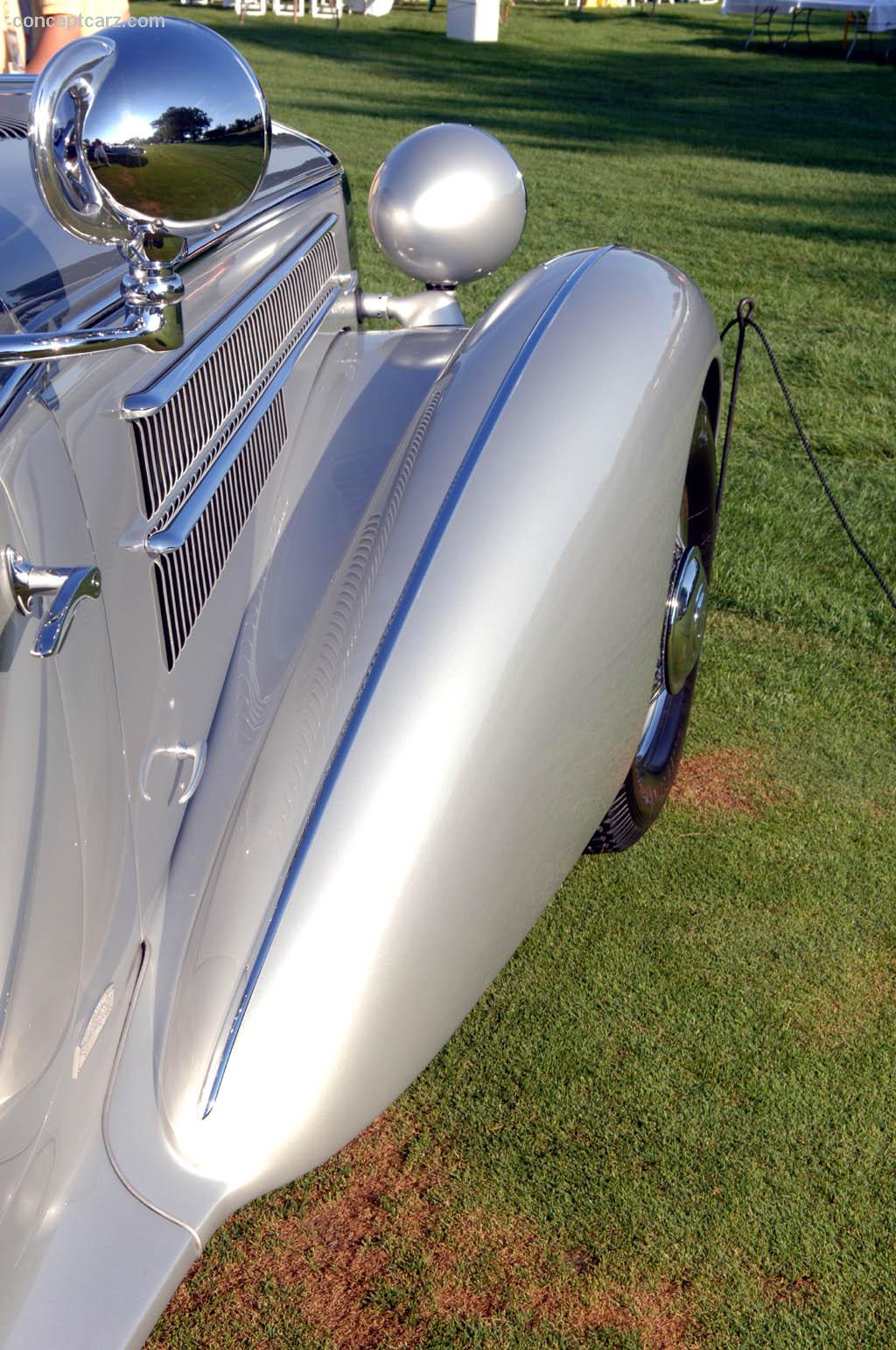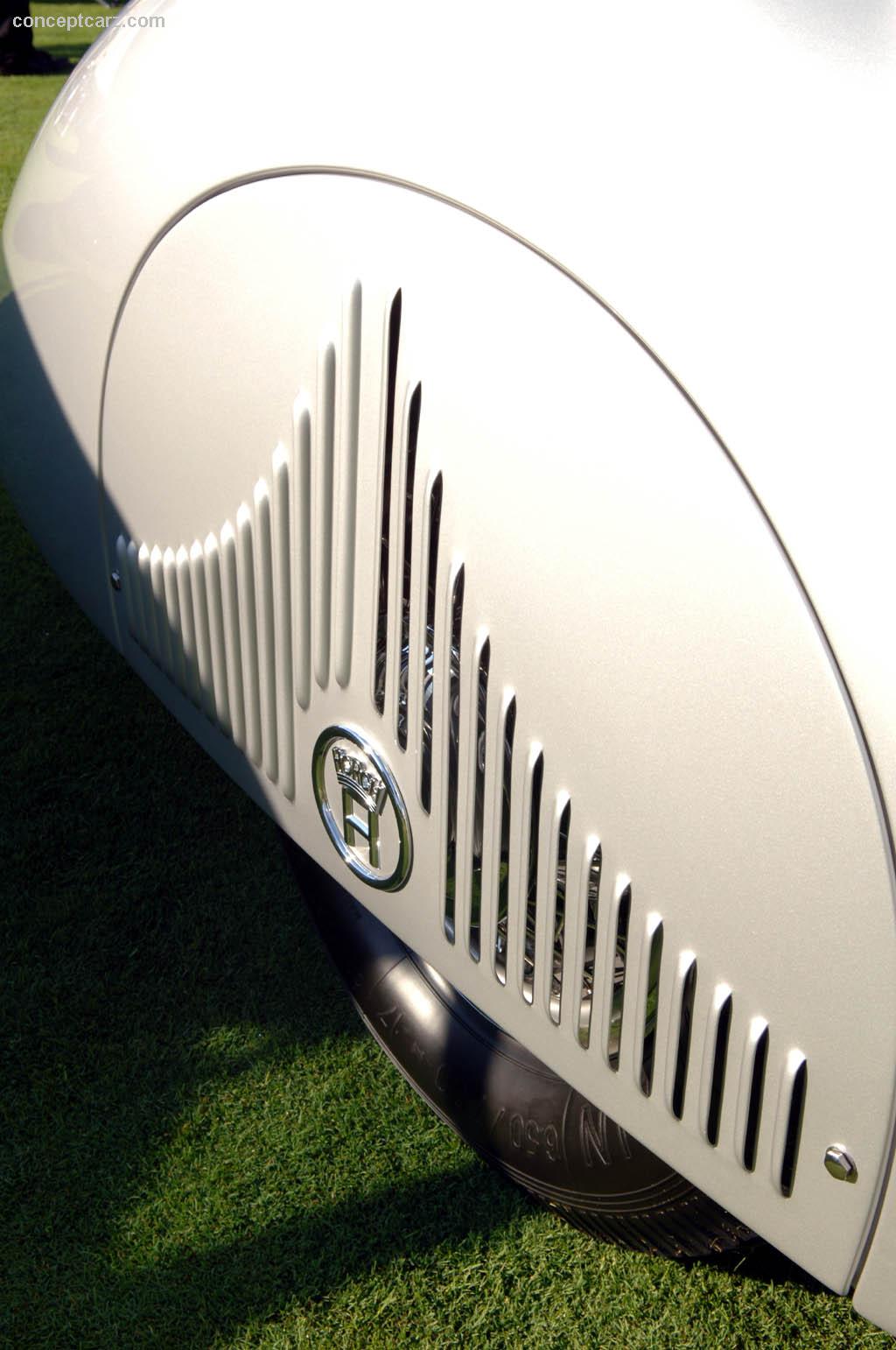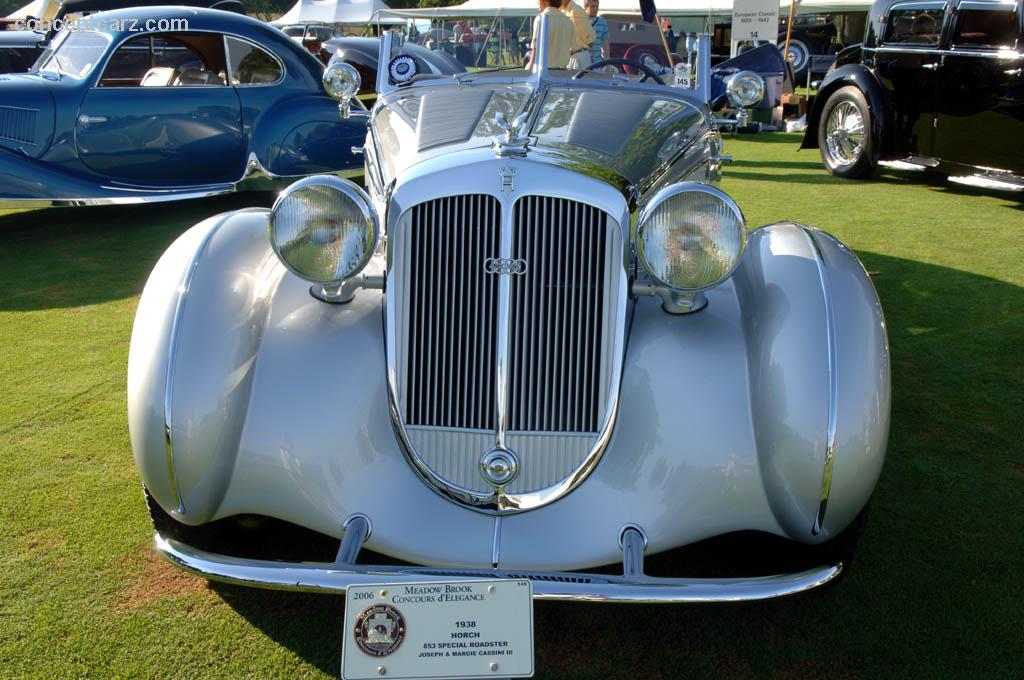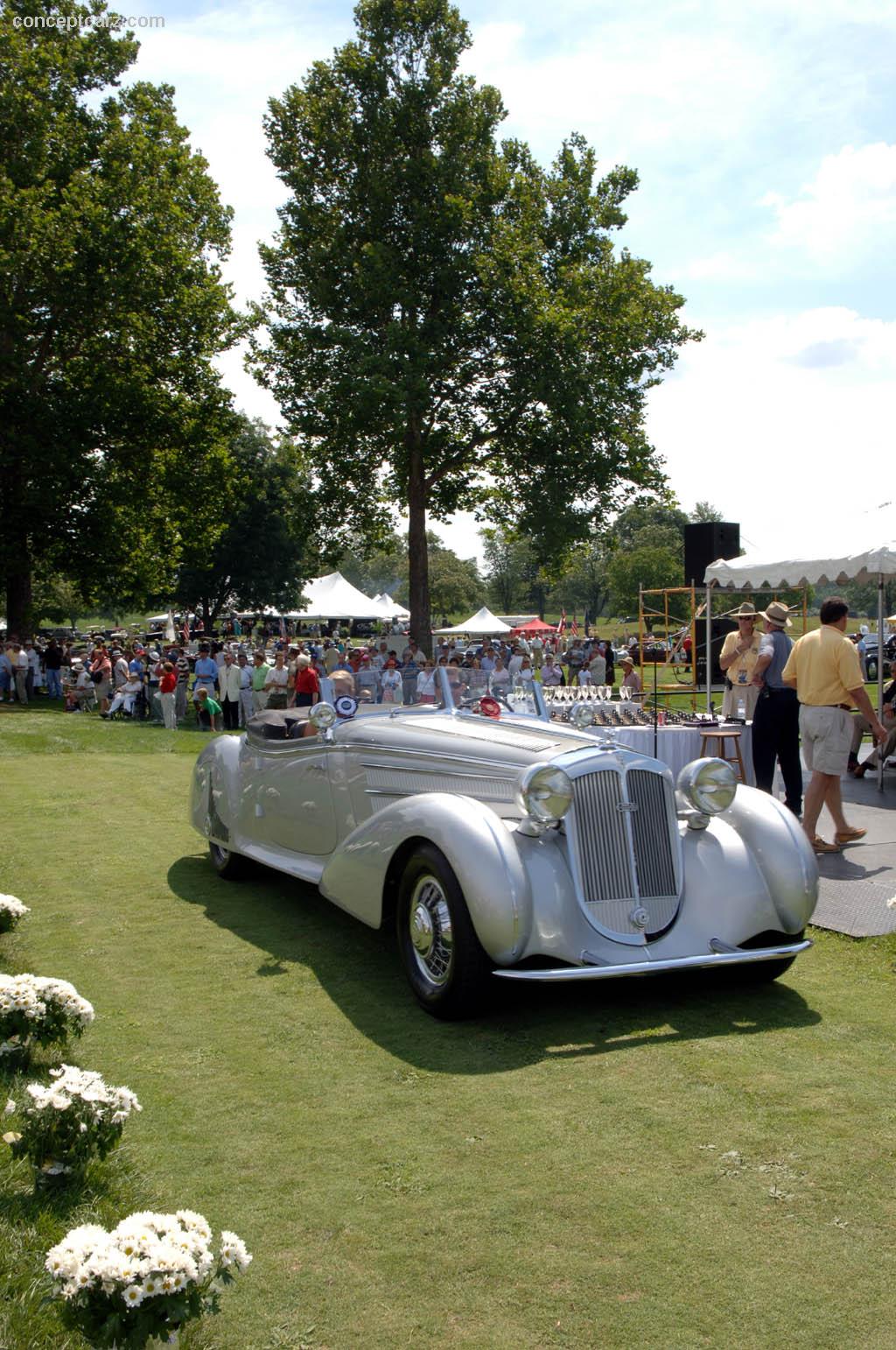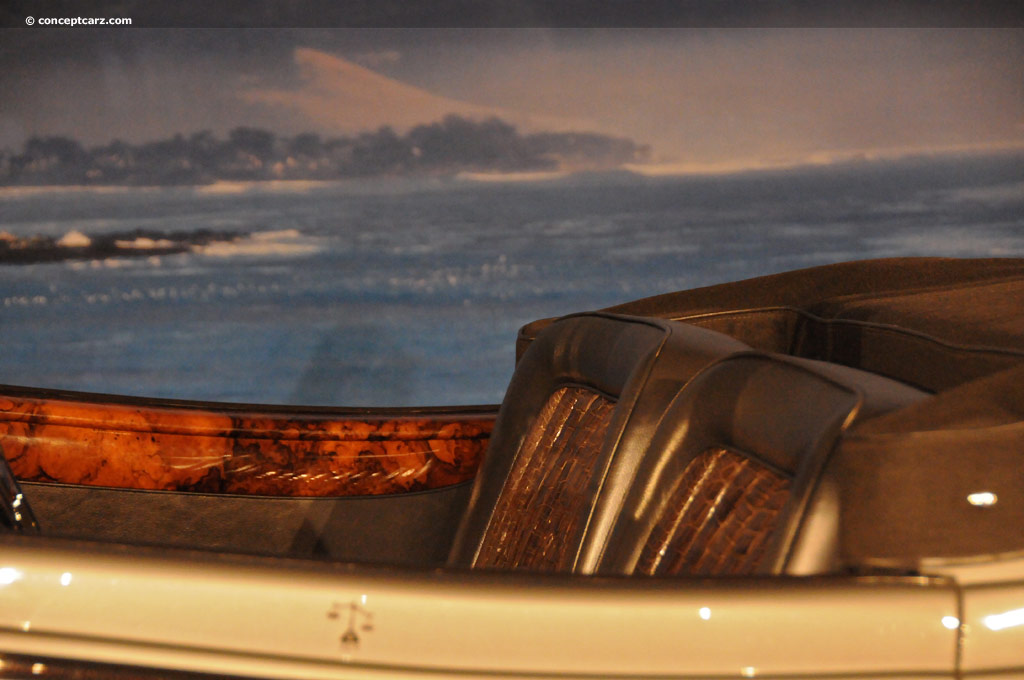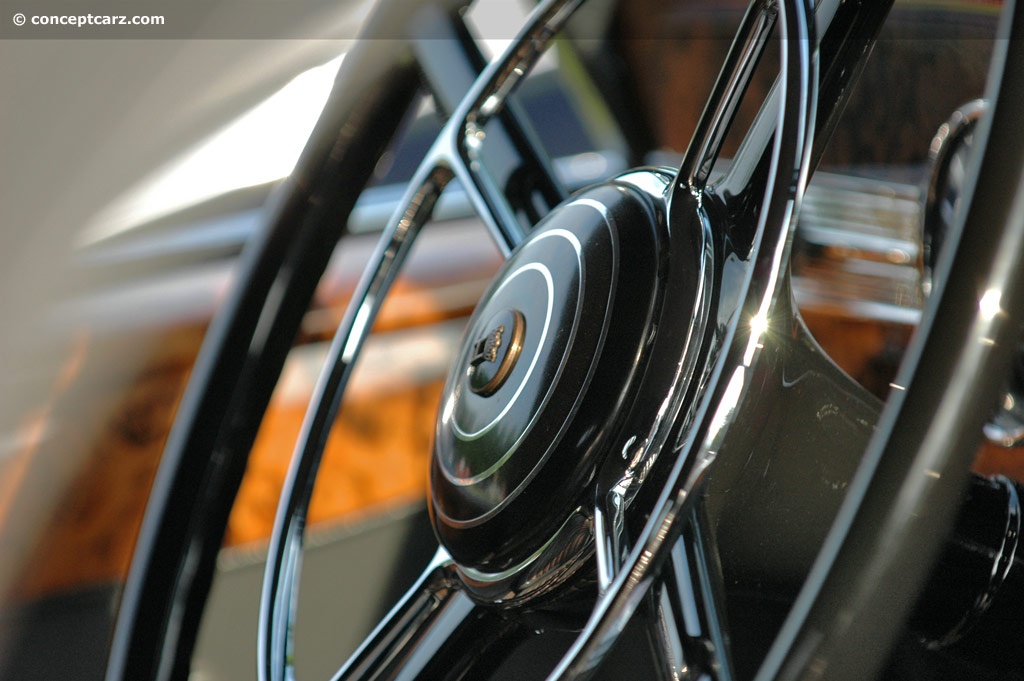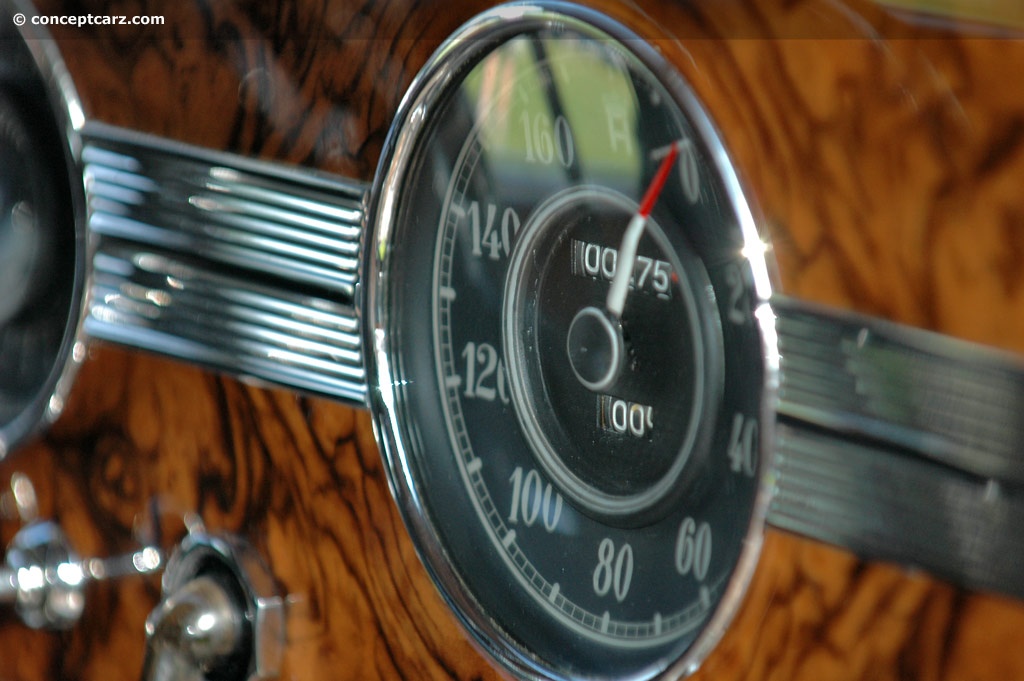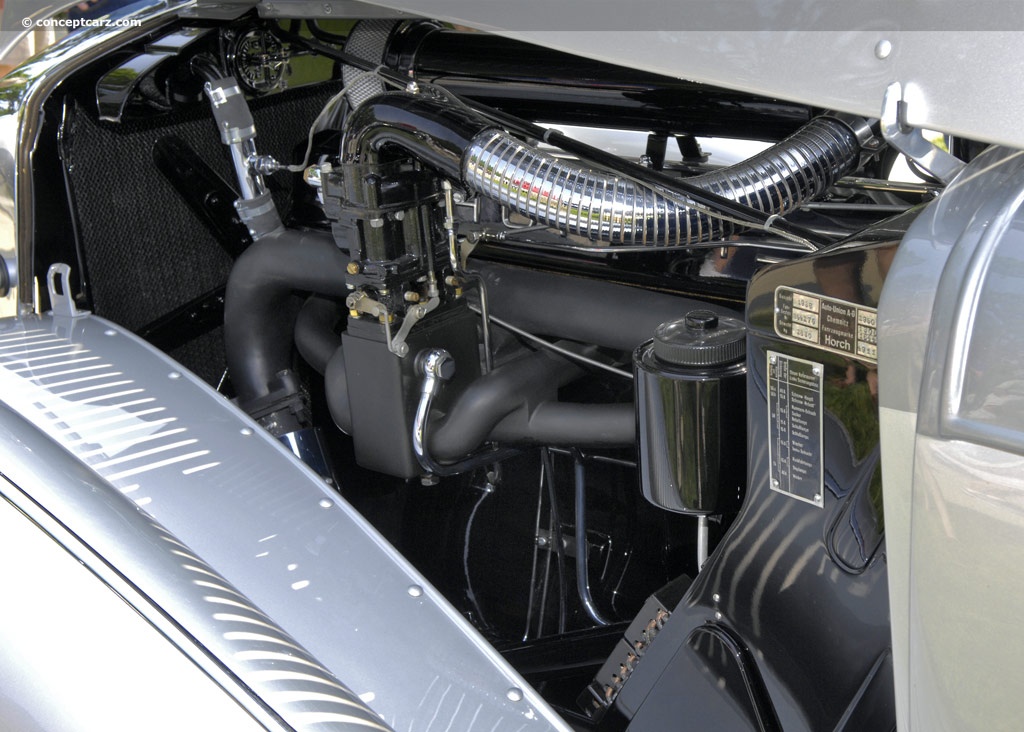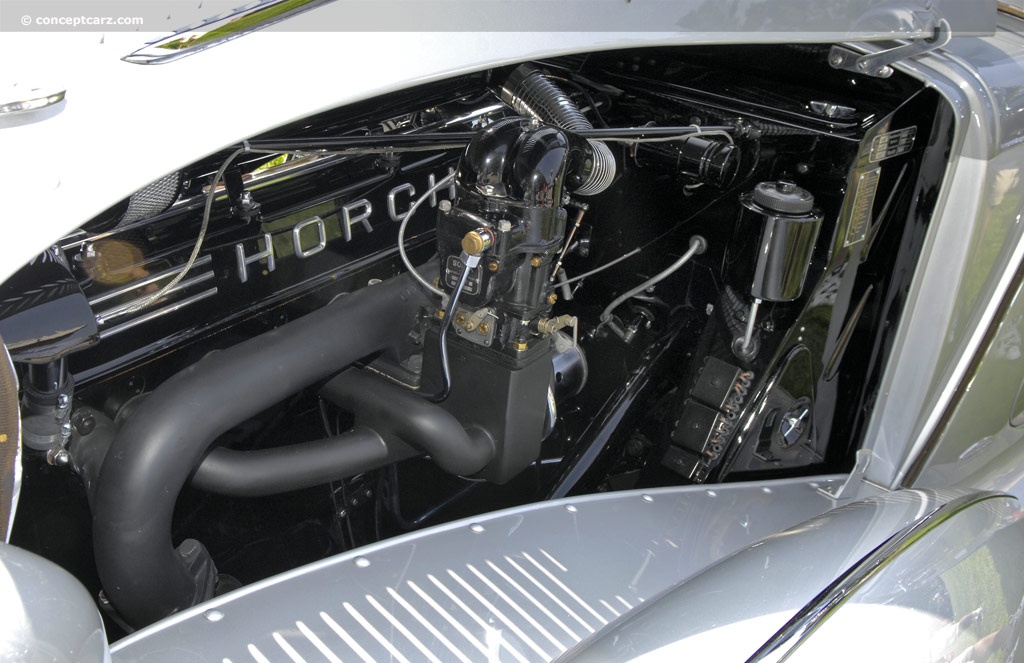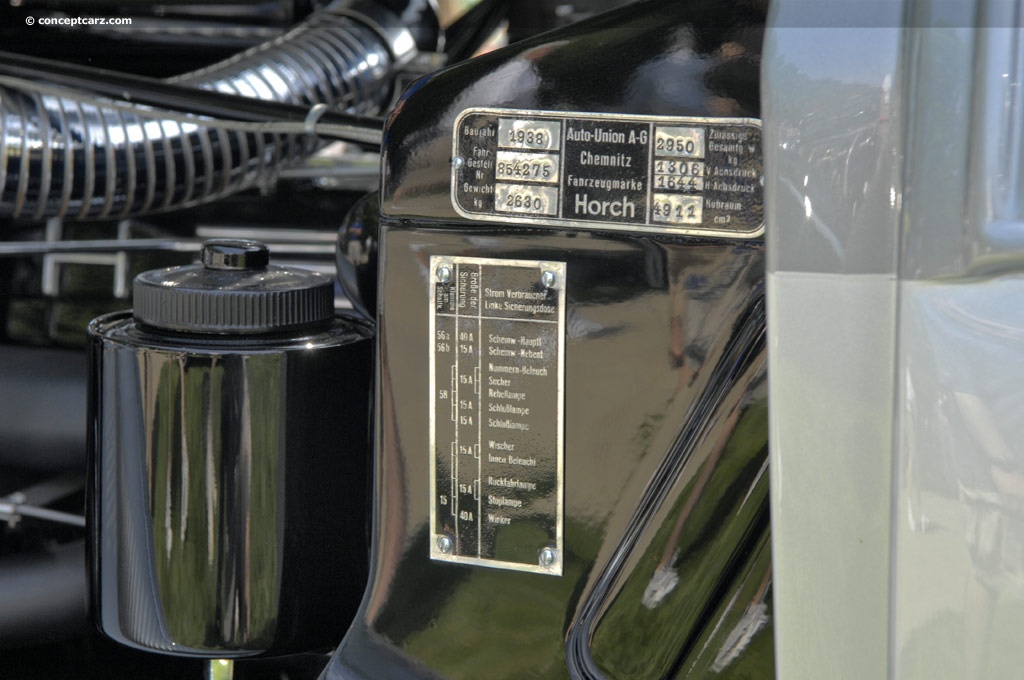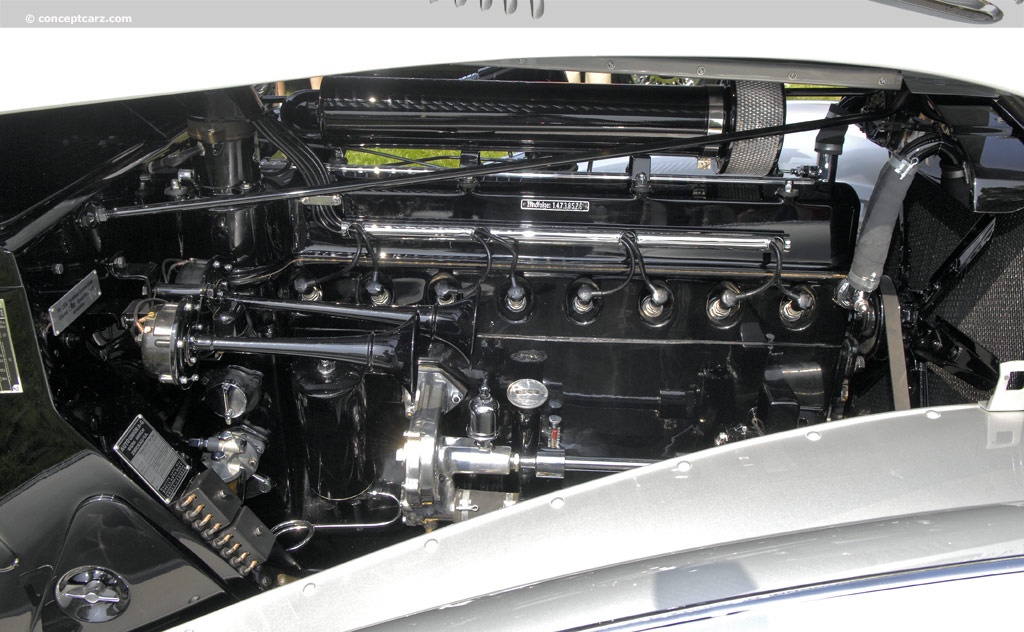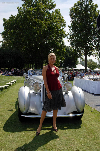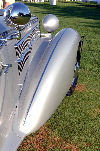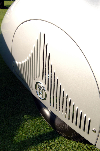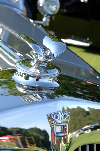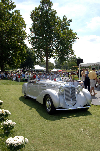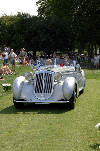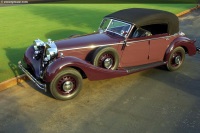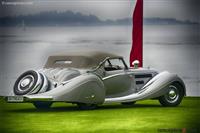Image credit: © conceptcarz.com (Reproduction Or reuse prohibited).
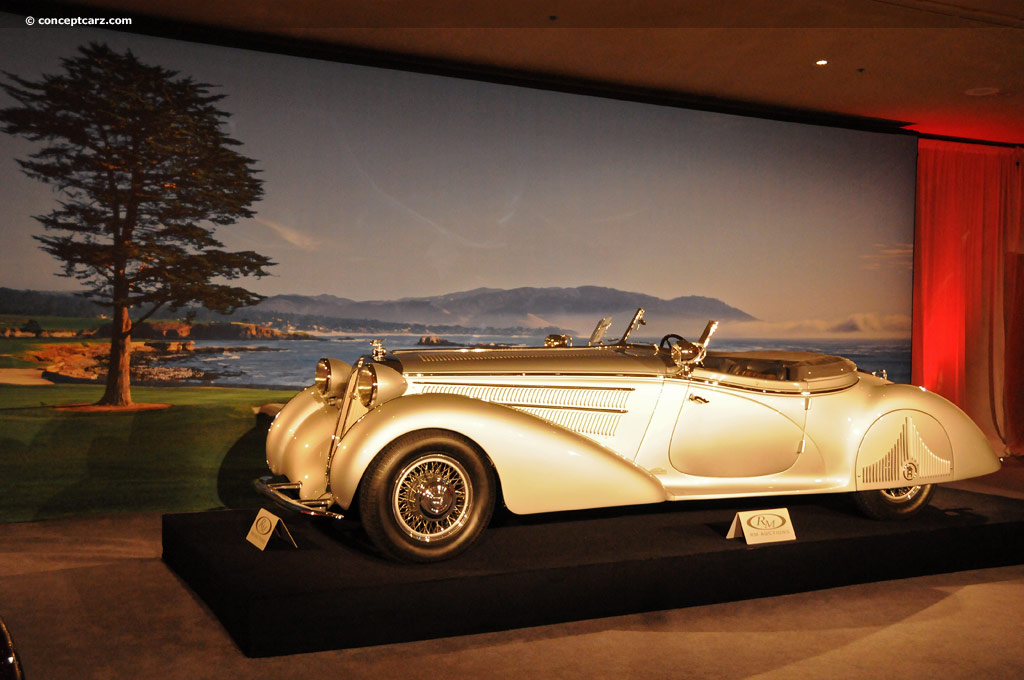
1938 Horch 853 Navigation
The Model 853 Special Roadster is the rarest of the straight-eight Horches, with only eight built in two series. The engine is a 4944cc OHV design producing 120 bhp at 3600 rpm, and is accompanied by a four-speed transmission with overdrive. The suspension is independent at all four corners, and the car is equipped with hydraulic brakes with servo assist. The roadster weighs in at 5,798 lb, and has a top speed of 84 mph. The 853 was referred to in Horch literature as being built on a 'short wheelbase,' but shortness is indeed relative since the wheelbase measures 135 inches. The 853s were bodied by Erdmann & Rossi, and each was slightly different. This example, the fourth car of the second series, was commissioned in January 1938 and has undergone a 12,000-hour restoration by RM Classic Cars in Blenheim, Canada.
In 2004 it was brought to the Pebble Beach Concours d'Elegance where it was awarded Best of Show.
The Horch Company did not survive the war. The German government had taken over the plants in 1939, and after World War Two, the factory was nationalized.
In 2004 it was brought to the Pebble Beach Concours d'Elegance where it was awarded Best of Show.
The Horch Company did not survive the war. The German government had taken over the plants in 1939, and after World War Two, the factory was nationalized.
Meaning to 'hear' or 'listen', August Horch's line of automobiles is certainly something more to behold than just to hear, for it would be what the eyes would see that whole could be truly appreciated. And perhaps none of the Horch models could be more appreciated for their beauty and elegance than the model 853.
In 1896, August Horch would see his first automobile, which would be a Benz. In a matter of months, Horch would be working for Benz and would ultimately be a plant manager. By 1899, Horch would manage to find enough financial backing to start his own automobile manufacturing company. And, just before the turn of the century, he would found Horch and Co.
From its very beginnings, Horch would become synonymous with quality and innovation. However, by 1910, the turmoil in Europe was beginning to brew and sales lagged for Horch's company. Known for quality and reliability, Horch's automobiles began to suffer from problems in touring events and he would soon be forced out of the very company bearing his name.
Unable to use his name, Horch would turn to the Latin translation word meaning 'to hear', or, 'listen'. So, instead of Horch, 'Audi' would be born. Soon, Horch's new company would pick right up where his old one had left off. Audi would become known for quality and performance. However, the end of the First World War would leave much of Europe, especially Germany, in shambles, and such luxury cars, as the Audis were, would not fare so well in the financial climate. As a result, Horch left the company in 1920. Unfortunately, for Audi, and fortunate for Horch, the economic woes facing Germany and Europe in the late 1920s and 1930s would leave production flat, if not in the decline. This potentially spelled doom for Audi and a few other companies.
The four struggling companies, two of them started by August Horch, would join together. Together, Audi, DKW, Horch and Wanderer would create Auto Union, and quickly, Auto Union would begin to rival Mercedes-Benz as Germany's great automobile manufacturer. And in the racing world, the Silver Arrows of Mercedes-Benz and Auto Union would become a force that would not only dominate grand prix races, but that would also set records that would take years to overcome.
When Auto Union came into existence, August Horch, who started two of the companies that made of the union, would be reinstated as head of Horchwerke. The union of the four rings would allow Horch to continue on as a luxury automobile manufacturer.
Auto Union would enter the world of grand prix racing and would routinely battle with Mercedes-Benz for victory after victory. This dominance would give rise to the name 'Silver Arrows.' But the competition between the two German automobile manufacturers wouldn't just be reserved for the circuit. And by the later part of the 1930s Horch would find itself in competition with Mercedes-Benz, not on the track but in the production of luxury road cars.
Horch had always been known for its quality and innovation but its reputation would be challenged greatly when Mercedes-Benz unveiled its new 540K. Immediately, Horch began to design a concept meant to compete with the new Mercedes. Carved out of wood, the Horch Special Roadster would be undertaken by the factory works in Malan. And though the car's chassis would begin production, the cars would not be made available for sale, at least not right away. The delay would have to do with whether or not the engines would be supercharged.
The decision would be made not to supercharge the 5.0-liter inline eight-cylinder engine. However, the transmission would be equipped with an overdrive, which would give it performance close, but not quite the same, as the 540K. However, the chassis would boast of a fully independent De Dion rear suspension placed on double-jointed rear axle shafts designed by Porsche.
What would be considered the 'First Series' would be quite similar to the concept that had been carved out of wood. The first example would be built by the factory. The second example would be designed and built by exceptional coachbuilders from Berlin, Erdmann and Rossi.
At the time, the Second World War loomed and the Nazi party had complete power throughout Germany. Therefore, Horch would be competing with Mercedes-Benz building cars, especially parade cars, for high-ranking members of the Third Reich. Horch would build the first example of the 'Second Series' especially for Hermann Goering, commander-in-chief for the German Luftwaffe. However, Mercedez would also be building a special 540K for him as well, an example with beefed-up protection, more so than that would be employed on the Horch. Goering would go with the Mercedes and would have the Horch, which had been built especially for him, dismantled.
Just five of the 'Second Series' 853s would be built. The first would be dismantled by Goering and the last would be lost. This would leave just three examples of the 'Second Series'. And though all five would share the same 'sweep panel' in the body sides and the beautifully-shaped fender skirts, each one would be quite unique in its design.
Chassis 854275 would be just one of the three remaining 'Second Series' 853s and would be one of the very few to feature coachwork by Erdmann and Rossi. And given the fact that just five of the 'Second Series' models would be built, and that each one was quite its own car, this 1938-built Horch 853A Special Roadster would be of much more extraordinary rarity than any of the 540K Mercedes.
But the 853 is not just a rare jewel today. Even in its day and potential buyer had to demonstrate they had at least a certain amount of money in the bank before they would even be considered a potential customer. This would be one of the main reasons why the 853 would be manufactured specifically for prominent government officials within the Nazi government.
This particular example would become a war souvenir for a United States serviceman returning after World War II. From Germany, the car would be shipped to the United States and then on to Cleveland, Ohio, where the serviceman would open a filling station. His intention would be to restore the car to its original condition. He would dismantle a good portion of the car but would never get around to the restoration.
The car would continue to sit in its non-restored state until the 1960s when collector Herbert von Fragstein came calling searching for one of the Special Roadsters. And though it would take a number of phone calls and he would eventually locate the 853A it wouldn't be until 1973 that he would come to own the car with the expectation of restoring the car to its former glory.
However, the restoration would never even begin. The car would still sit in pieces, but it would be joined by some original parts that von Fragstein would manage to locate over the years. It was clear the intention was to rebuild and restore the car, though it would never happen. But thankfully, there would be one that would have the means of making it finally happen.
In 2001, the car was acquired by the famous collector Joseph Cassini. Cassini had seen one of the Special Roadsters years earlier and had become aware of chassis 854275. Fully aware of the condition of the car Cassini would relate, 'It was a beautiful car, and I saw this example as an opportunity to take a diamond in the rough and realize its true potential.' Cassini would turn to RM Auto Restoration and the two-year process would begin.
The car would be thoroughly dismantled, and every part would be catalogued. Amazingly, the car would be found to have many of its original components. But this was just the beginning. The car would be stripped right down to the chassis so that each component could be inspected and cleaned. As to the wood components used in the car, a good amount of the original wood be able to be saved though some of the ash framing would need to be replaced. It would only be during this tear-down and restoration phase of the project that the true quality of the Horch construction process would be truly appreciated.
Overall, much of the car was in good shape. And where there were some needed repairs, great pains would be taken to save as much of the original elements as possible. A true restoration of the car could not have been completed without several trips to Germany to inspect original photographs and other technical data. The entire project would take more than 12,000 hours, but it would be the final stages that would be as important and much more difficult.
While the restoration of the car required tremendous amounts of sweat, toil and investigation, the car's finish would be agonized over perhaps even more. The finish, after all, would serve as the final testament to the car's restoration. As a result, the decision would be made to finish the car in a period-correct livery that would only enhance its rare lineage and exotic pedigree. Therefore, the car would be finished in a silver and two-tone grey. Just one glimpse and the finish evokes those images of the famed Silver Arrows of Auto Union and Mercedes that dominated the racing scene throughout pre-war Europe.
The finished product could not be described with any other proper adjective other than 'stunning'. The handcrafted elements, the leather and alligator upholstery and the finish and design of the 853A blend together into a rich and remarkably beautiful creation befitting of the Horch reputation for luxury and quality.
After the dedicated and exhaustive restoration, the car would be entered in the Pebble Beach Concours d'Elegance. Complete with its restored inline eight-cylinder engine, four-speed synchromesh transmission, wonderful touches of chrome and its wonderfully crafted Erdmann and Rossi coachwork, the car would go on to win the coveted Best in Show award in 2004. It would be the final confirmation as to the work of the restoration and the special place in automotive history the Horch 853 holds.
The Best in Show award earned at Pebble Beach would then be followed by numerous other concours victories including the 2005 New York Concours and the 2006 Meadow Brook concours. These victories would be followed up with awards at the Glenmore Gathering in 2008, Ault Park in 2009, and another at Greenwich in 2012.
Judge Cassini has owned several exotic and rare cars throughout his life. In fact, he has owned some of the best marques known on the planet. However, the Horch always has held a special place in his heart. Judge Cassini would remark about his Horch, 'I've had some really outstanding cars—but the Horch is at the top of the pile…'
Accented with such touches as chromed bezels, ornamental fluted louvers, chromed deco Horch logo, a burled walnut veneer and a luxurious fully fitted headliner in the convertible top, the Horch 853A, chassis 854275 certainly began its life as a rare luxurious beauty. As a result of its dedicated restoration, award-winning presence and extraordinary rarity only add to its value and reputation. And amongst the already rare and exceptional Horch automobiles, the Special Roadsters, of which 864275 is one of just three surviving, would have to be regarded as one of the finest of designs in Europe and the rest of the world.
As a result of the tremendous and award-winning restoration, the 1938 Horch 853A Special Roadster would be expected to draw between $6,000,000 and $8,000,000 at auction.
Sources:
'Lot No. 133: 1938 Horch 853A Special Roadster by Erdmann and Rossi', (http://www.rmauctions.com/FeatureCars.cfm?SaleCode=MO12&CarID=r159). RM Auctions. http://www.rmauctions.com/FeatureCars.cfm?SaleCode=MO12&CarID=r159. Retrieved 1 August 2012.
'1938 Horch 853 Phaeton News, Pictures and Information', (http://www.conceptcarz.com/vehicle/z11989/Horch-853-Phaeton.aspx.). Conceptcarz.com: From Concept to Production. http://www.conceptcarz.com/vehicle/z11989/Horch-853-Phaeton.aspx. Retrieved 1 August 2012.
'Horch 853 Sport Cabriolet', (http://www.ultimatecarpage.com/car/2066/Horch-853-Sport-Cabriolet.html). Ultimatecarpage.com: Powered by Knowledge, Driven by Passion. http://www.ultimatecarpage.com/car/2066/Horch-853-Sport-Cabriolet.html. Retrieved 1 August 2012.
Wikipedia contributors, 'Horch', Wikipedia, The Free Encyclopedia, 31 July 2012, 13:49 UTC, http://en.wikipedia.org/w/index.php?title=Horch&oldid=500535116 accessed 1 August 2012
By Jeremy McMullen
In 1896, August Horch would see his first automobile, which would be a Benz. In a matter of months, Horch would be working for Benz and would ultimately be a plant manager. By 1899, Horch would manage to find enough financial backing to start his own automobile manufacturing company. And, just before the turn of the century, he would found Horch and Co.
From its very beginnings, Horch would become synonymous with quality and innovation. However, by 1910, the turmoil in Europe was beginning to brew and sales lagged for Horch's company. Known for quality and reliability, Horch's automobiles began to suffer from problems in touring events and he would soon be forced out of the very company bearing his name.
Unable to use his name, Horch would turn to the Latin translation word meaning 'to hear', or, 'listen'. So, instead of Horch, 'Audi' would be born. Soon, Horch's new company would pick right up where his old one had left off. Audi would become known for quality and performance. However, the end of the First World War would leave much of Europe, especially Germany, in shambles, and such luxury cars, as the Audis were, would not fare so well in the financial climate. As a result, Horch left the company in 1920. Unfortunately, for Audi, and fortunate for Horch, the economic woes facing Germany and Europe in the late 1920s and 1930s would leave production flat, if not in the decline. This potentially spelled doom for Audi and a few other companies.
The four struggling companies, two of them started by August Horch, would join together. Together, Audi, DKW, Horch and Wanderer would create Auto Union, and quickly, Auto Union would begin to rival Mercedes-Benz as Germany's great automobile manufacturer. And in the racing world, the Silver Arrows of Mercedes-Benz and Auto Union would become a force that would not only dominate grand prix races, but that would also set records that would take years to overcome.
When Auto Union came into existence, August Horch, who started two of the companies that made of the union, would be reinstated as head of Horchwerke. The union of the four rings would allow Horch to continue on as a luxury automobile manufacturer.
Auto Union would enter the world of grand prix racing and would routinely battle with Mercedes-Benz for victory after victory. This dominance would give rise to the name 'Silver Arrows.' But the competition between the two German automobile manufacturers wouldn't just be reserved for the circuit. And by the later part of the 1930s Horch would find itself in competition with Mercedes-Benz, not on the track but in the production of luxury road cars.
Horch had always been known for its quality and innovation but its reputation would be challenged greatly when Mercedes-Benz unveiled its new 540K. Immediately, Horch began to design a concept meant to compete with the new Mercedes. Carved out of wood, the Horch Special Roadster would be undertaken by the factory works in Malan. And though the car's chassis would begin production, the cars would not be made available for sale, at least not right away. The delay would have to do with whether or not the engines would be supercharged.
The decision would be made not to supercharge the 5.0-liter inline eight-cylinder engine. However, the transmission would be equipped with an overdrive, which would give it performance close, but not quite the same, as the 540K. However, the chassis would boast of a fully independent De Dion rear suspension placed on double-jointed rear axle shafts designed by Porsche.
What would be considered the 'First Series' would be quite similar to the concept that had been carved out of wood. The first example would be built by the factory. The second example would be designed and built by exceptional coachbuilders from Berlin, Erdmann and Rossi.
At the time, the Second World War loomed and the Nazi party had complete power throughout Germany. Therefore, Horch would be competing with Mercedes-Benz building cars, especially parade cars, for high-ranking members of the Third Reich. Horch would build the first example of the 'Second Series' especially for Hermann Goering, commander-in-chief for the German Luftwaffe. However, Mercedez would also be building a special 540K for him as well, an example with beefed-up protection, more so than that would be employed on the Horch. Goering would go with the Mercedes and would have the Horch, which had been built especially for him, dismantled.
Just five of the 'Second Series' 853s would be built. The first would be dismantled by Goering and the last would be lost. This would leave just three examples of the 'Second Series'. And though all five would share the same 'sweep panel' in the body sides and the beautifully-shaped fender skirts, each one would be quite unique in its design.
Chassis 854275 would be just one of the three remaining 'Second Series' 853s and would be one of the very few to feature coachwork by Erdmann and Rossi. And given the fact that just five of the 'Second Series' models would be built, and that each one was quite its own car, this 1938-built Horch 853A Special Roadster would be of much more extraordinary rarity than any of the 540K Mercedes.
But the 853 is not just a rare jewel today. Even in its day and potential buyer had to demonstrate they had at least a certain amount of money in the bank before they would even be considered a potential customer. This would be one of the main reasons why the 853 would be manufactured specifically for prominent government officials within the Nazi government.
This particular example would become a war souvenir for a United States serviceman returning after World War II. From Germany, the car would be shipped to the United States and then on to Cleveland, Ohio, where the serviceman would open a filling station. His intention would be to restore the car to its original condition. He would dismantle a good portion of the car but would never get around to the restoration.
The car would continue to sit in its non-restored state until the 1960s when collector Herbert von Fragstein came calling searching for one of the Special Roadsters. And though it would take a number of phone calls and he would eventually locate the 853A it wouldn't be until 1973 that he would come to own the car with the expectation of restoring the car to its former glory.
However, the restoration would never even begin. The car would still sit in pieces, but it would be joined by some original parts that von Fragstein would manage to locate over the years. It was clear the intention was to rebuild and restore the car, though it would never happen. But thankfully, there would be one that would have the means of making it finally happen.
In 2001, the car was acquired by the famous collector Joseph Cassini. Cassini had seen one of the Special Roadsters years earlier and had become aware of chassis 854275. Fully aware of the condition of the car Cassini would relate, 'It was a beautiful car, and I saw this example as an opportunity to take a diamond in the rough and realize its true potential.' Cassini would turn to RM Auto Restoration and the two-year process would begin.
The car would be thoroughly dismantled, and every part would be catalogued. Amazingly, the car would be found to have many of its original components. But this was just the beginning. The car would be stripped right down to the chassis so that each component could be inspected and cleaned. As to the wood components used in the car, a good amount of the original wood be able to be saved though some of the ash framing would need to be replaced. It would only be during this tear-down and restoration phase of the project that the true quality of the Horch construction process would be truly appreciated.
Overall, much of the car was in good shape. And where there were some needed repairs, great pains would be taken to save as much of the original elements as possible. A true restoration of the car could not have been completed without several trips to Germany to inspect original photographs and other technical data. The entire project would take more than 12,000 hours, but it would be the final stages that would be as important and much more difficult.
While the restoration of the car required tremendous amounts of sweat, toil and investigation, the car's finish would be agonized over perhaps even more. The finish, after all, would serve as the final testament to the car's restoration. As a result, the decision would be made to finish the car in a period-correct livery that would only enhance its rare lineage and exotic pedigree. Therefore, the car would be finished in a silver and two-tone grey. Just one glimpse and the finish evokes those images of the famed Silver Arrows of Auto Union and Mercedes that dominated the racing scene throughout pre-war Europe.
The finished product could not be described with any other proper adjective other than 'stunning'. The handcrafted elements, the leather and alligator upholstery and the finish and design of the 853A blend together into a rich and remarkably beautiful creation befitting of the Horch reputation for luxury and quality.
After the dedicated and exhaustive restoration, the car would be entered in the Pebble Beach Concours d'Elegance. Complete with its restored inline eight-cylinder engine, four-speed synchromesh transmission, wonderful touches of chrome and its wonderfully crafted Erdmann and Rossi coachwork, the car would go on to win the coveted Best in Show award in 2004. It would be the final confirmation as to the work of the restoration and the special place in automotive history the Horch 853 holds.
The Best in Show award earned at Pebble Beach would then be followed by numerous other concours victories including the 2005 New York Concours and the 2006 Meadow Brook concours. These victories would be followed up with awards at the Glenmore Gathering in 2008, Ault Park in 2009, and another at Greenwich in 2012.
Judge Cassini has owned several exotic and rare cars throughout his life. In fact, he has owned some of the best marques known on the planet. However, the Horch always has held a special place in his heart. Judge Cassini would remark about his Horch, 'I've had some really outstanding cars—but the Horch is at the top of the pile…'
Accented with such touches as chromed bezels, ornamental fluted louvers, chromed deco Horch logo, a burled walnut veneer and a luxurious fully fitted headliner in the convertible top, the Horch 853A, chassis 854275 certainly began its life as a rare luxurious beauty. As a result of its dedicated restoration, award-winning presence and extraordinary rarity only add to its value and reputation. And amongst the already rare and exceptional Horch automobiles, the Special Roadsters, of which 864275 is one of just three surviving, would have to be regarded as one of the finest of designs in Europe and the rest of the world.
As a result of the tremendous and award-winning restoration, the 1938 Horch 853A Special Roadster would be expected to draw between $6,000,000 and $8,000,000 at auction.
Sources:
'Lot No. 133: 1938 Horch 853A Special Roadster by Erdmann and Rossi', (http://www.rmauctions.com/FeatureCars.cfm?SaleCode=MO12&CarID=r159). RM Auctions. http://www.rmauctions.com/FeatureCars.cfm?SaleCode=MO12&CarID=r159. Retrieved 1 August 2012.
'1938 Horch 853 Phaeton News, Pictures and Information', (http://www.conceptcarz.com/vehicle/z11989/Horch-853-Phaeton.aspx.). Conceptcarz.com: From Concept to Production. http://www.conceptcarz.com/vehicle/z11989/Horch-853-Phaeton.aspx. Retrieved 1 August 2012.
'Horch 853 Sport Cabriolet', (http://www.ultimatecarpage.com/car/2066/Horch-853-Sport-Cabriolet.html). Ultimatecarpage.com: Powered by Knowledge, Driven by Passion. http://www.ultimatecarpage.com/car/2066/Horch-853-Sport-Cabriolet.html. Retrieved 1 August 2012.
Wikipedia contributors, 'Horch', Wikipedia, The Free Encyclopedia, 31 July 2012, 13:49 UTC, http://en.wikipedia.org/w/index.php?title=Horch&oldid=500535116 accessed 1 August 2012
By Jeremy McMullen
2012 RM Auctions - Monterey
Pre-Auction Estimates :
USD $6,000,000-USD $8,000,000
Sale Price :
USD $5,170,000
1938 Horch 853 Auction Sales
Recent Sales of the Horch 853
(Data based on Model Year 1938 sales)
| 1938 Horch 853 Sport Cabriolet Chassis#: 853286 Sold for USD$374,000 2022 RM Sothebys : Fort Lauderdale | |
| 1938 Horch 853A Sportcabriolet Chassis#: 854126 Sold for USD$305,930 2019 Bonhams : The Bonmont Sale | |
| 1938 Horch 853 A cabriolet Chassis#: 854192A Sold for USD$635,282 2017 Artcurial : Retromobile | |
| 1938 Horch 853A Sportcabriolet Chassis#: 854126 Sold for USD$707,388 2016 Bonhams : The Chantilly Sale | |
| 1938 Horch 853 Cabriolet Chassis#: 853400 Sold for USD$423,902 2015 Bonhams : Les Grandes Marques du Monde au Grand Palais | |
| 1939 Horch 853A Special Roadster Chassis#: 854275 Sold for USD$5,170,000 2012 RM Auctions - Monterey |   |
| 1938 Horch 853 cabriolet Sold for USD$534,396 2012 Artcurial Motorcars at Rétromobile | |
| 1938 Horch 853 Special Roadster Chassis#: 854268 Sold for USD$722,502 2008 Automobiles of London |
Horch 853s That Failed To Sell At Auction
1938 Horch 853's that have appeared at auction but did not sell.
| Vehicle | Chassis | Event | High Bid | Est. Low | Est. High |
|---|---|---|---|---|---|
| 1938 Horch 853 Cabriolet by Gläser | 853400 | 2017 RM Sotheby's : Paris | $450,000 | $550,000 |
Vehicles With Comparable Market Values
Similar sales to the $1,109,175 range.
| 2009 RUF CTR3 Chassis#:W09BM03879PR06002 Sold for $1,116,000 2025 RM Sothebys : ModaMiami |   |
| 2022 FORD GT Chassis#:2FAGP9CW5NH200136 Sold for $1,100,000 2025 Barrett-Jackson : Scottsdale | |
| 1957 Mercedes-Benz 300 SL Roadster Chassis#:198.042.7500315 Sold for $1,105,000 2024 RM Sothebys : Monterey | |
| 1914 Sunbeam Tourist Trophy Race Car Sold for $1,105,000 2024 Gooding & Company : Pebble Beach |   |
| 1973 McLaren M23 Chassis#:M23-2 Sold for $1,108,179 2024 RM Sothebys : Monaco | |
| 1957 MERCEDES-BENZ 300 SL ROADSTER Chassis#:198.042.7500473 Sold for $1,105,000 2024 Gooding & Co: Selections From The Mullin Collection Auction | |
| 1930 BUGATTI TYPE 46 SEMI-PROFILÉE COUPE Chassis#:46136 Sold for $1,105,000 2024 Gooding & Co: Selections From The Mullin Collection Auction | |
| 2022 FERRARI SF90 SPIDER Chassis#:ZFF96NMAXN0278208 Sold for $1,100,000 2024 Barrett-Jackson : Palm Beach | |
| 1954 Dodge Firearrow IV by Carrozzeria Ghia Chassis#:9999708 Sold for $1,100,000 2024 Broad Arrow Auctions : Amelia |   |
| 2015 McLaren P1 Chassis#:SBM12ABB7FW000285 Sold for $1,104,534 2024 RM Sothebys : Paris | |
| DONALD J. TRUMPS 1997 LAMBORGHINI DIABLO VT ROADSTER Chassis#:ZA9RU37B3VLA12842 Sold for $1,100,000 2024 Barrett-Jackson : Scottsdale AZ | |
| 1967 CHEVROLET CORVETTE CUSTOM CONVERTIBLE Chassis#:194677S109249 Sold for $1,100,000 2024 Barrett-Jackson : Scottsdale AZ | |
| 1954 Aston Martin DB2/4 Coupe by Bertone Chassis#:LML/765 Sold for $1,105,000 2023 RM Sothebys : New York |   |
| 2016 Porsche 911 R Chassis#:WP0AF2A94GS195255 Sold for $1,105,000 2023 RM Sothebys : The White Collection | |
| 2023 BMW 3.0 CSL Chassis#:WBS81AZ090CM08044 Sold for $1,113,686 2023 RM Sothebys : Munich | |
| 1967 Ferrari 330 GTS by Pininfarina Chassis#:9715 Sold for $1,116,000 2023 RM Sothebys : Monterey |   |
| 1956 Chrysler 300B Coupe Speciale by Boano Chassis#:3N561171 Sold for $1,105,000 2023 RM Sothebys : Monterey |   |
| 1937 Delage D8-120 Letourneur et Marchand Coach JeL Chassis#:50789 Sold for $1,105,000 2023 Broad Arrow : Monterey Jet Center |   |
| 2012 Lexus LFA Chassis#:JTHHX8BH5C1000184 Sold for $1,105,000 2023 RM Sothebys : Monterey |  |
| 1930 Cadillac V-16 Roadster by Fleetwood Sold for $1,105,000 2023 RM Sothebys : Amelia Island |   |
1938 Horch 853
• Additional valuation insight and sales data• History
• Specifications
• Image gallery
• Other Horch 853 model years
